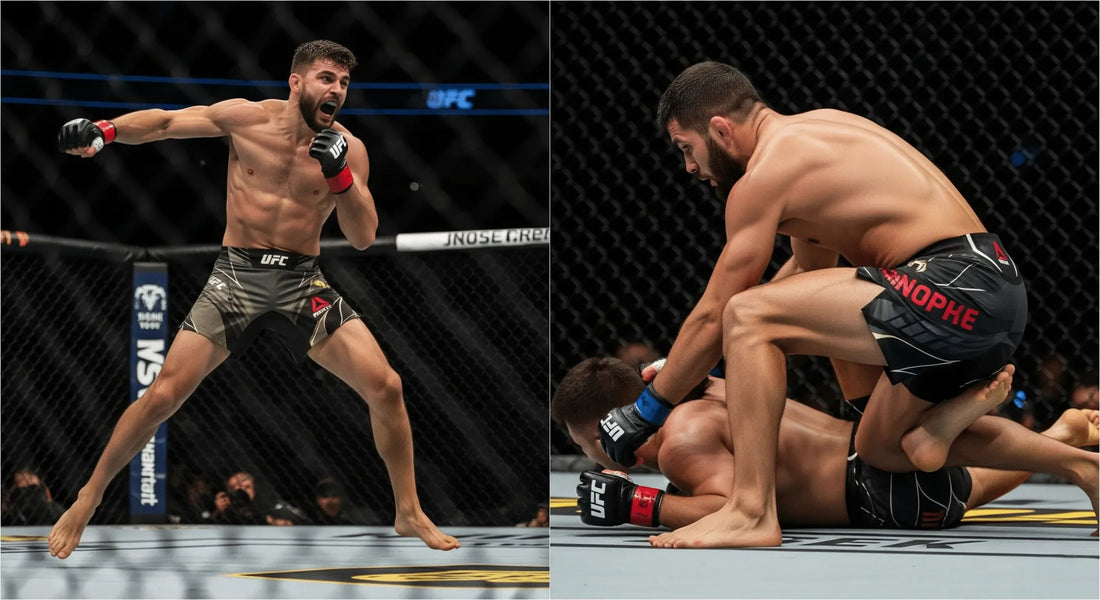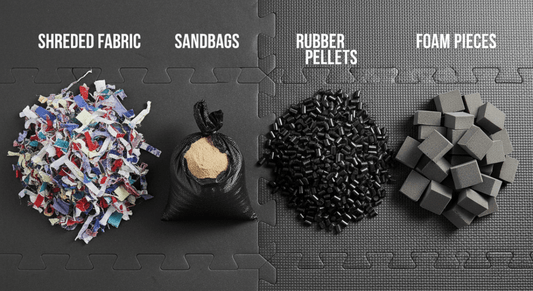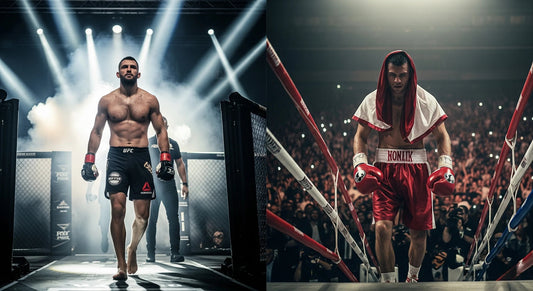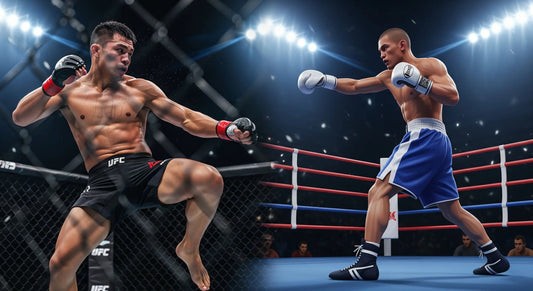
Best Takedown Techniques in MMA - Single, Double Leg & Hip Toss
Takedowns are the backbone of MMA because they bridge the gap between striking and grappling. In fact, according to UFC statistical reports, fighters who successfully score takedowns in at least two rounds win nearly 75 percent of their fights. That tells you how valuable these techniques are. For beginners, learning takedowns is not just about scoring points or slamming opponents to the mat. It’s about controlling where the fight takes place. If you are more comfortable on the ground, takedowns are your ticket there.

The beauty of takedowns lies in their versatility. They can be explosive and powerful, like a double-leg shot, or smooth and technical, like a hip toss. What makes them essential for beginners is that they force you to master balance, timing, and coordination skills that improve every part of your MMA game. Think of takedowns as the steering wheel of a car. Without them, you are stuck driving straight with no way to turn.
Beginners often worry that takedowns are too complicated. The truth is, once you break them down into steps, they become manageable. Every great fighter, from Khabib Nurmagomedov to Georges St-Pierre, built their success on just a few fundamental takedowns. Learning these basics will not only make you a more complete fighter but will also give you confidence when stepping into the cage.
Understanding the Fundamentals of Takedowns
Before diving into specific techniques, it’s important to understand the foundation of all takedowns: balance, leverage, and timing. A takedown isn’t just about brute strength. In fact, many smaller fighters regularly take down bigger opponents because they master these fundamentals.
-
Balance: You need to stay grounded with a strong base. Beginners often overreach, which makes them vulnerable to counters. Keeping your feet under you ensures stability.
-
Leverage: Instead of fighting strength with strength, you use angles and positioning. For example, driving your shoulder into the opponent’s hip gives you an edge without requiring overwhelming power.
-
Timing: This is the secret ingredient. A perfectly timed takedown can be unstoppable. The best moments are often when your opponent is off-balance, such as right after throwing a strike.
Footwork also plays a huge role. If your feet are in the wrong place, your takedown will fail before it starts. Beginners should drill basic movement patterns like penetration steps and level changes until they become second nature. A study from the Journal of Sports Science in 2020 found that athletes who focused on footwork efficiency had a 22 percent higher takedown success rate than those who didn’t. That’s proof that fundamentals matter.

One of the biggest beginner mistakes is shooting from too far away. If you launch yourself without closing the distance, you end up sprawled on and exhausted. Another mistake is keeping your head too low or too high, which breaks posture and reduces leverage. Mastering the basics early saves you from developing bad habits that are tough to fix later.
The Double-Leg Takedown
The double-leg takedown is the bread and butter of MMA wrestling. It is straightforward, effective, and works at all levels. To execute it, you start with a level change, dropping your hips lower than your opponent’s. Next comes the penetration step, where you drive your lead foot between their legs. Then, you shoot your arms around both legs, lock your hands, and drive forward using your head as a steering wheel against their torso or hip.

There are several variations. The classic double-leg involves driving straight through your opponent, often ending up in inside control. Another variation, the blast double, relies on explosive power to bulldoze through defences. Beginners should start with the standard double-leg, focusing on technique rather than speed.
Why is the double-leg so popular? According to FightMetric statistics, it accounts for nearly 45 percent of all takedowns landed in UFC history. Fighters like Georges St-Pierre turned it into a weapon by timing it perfectly after striking combinations. The key lesson here is that you don’t need to be a powerhouse wrestler to land it. With good timing and clean execution, even beginners can use it successfully.
Of course, there are defences against the double-leg, such as sprawling and using underhooks. But the reason it remains a staple is because it works in so many scenarios. Once you’ve taken your opponent down, you can transition to ground-and-pound, submissions, or positional control. If you’re just starting MMA, the double-leg should be at the top of your takedown list.
The Single-Leg Takedown
If the double-leg is the hammer, the single-leg is the scalpel. It’s precise, technical, and incredibly effective when done correctly. The setup is similar: you lower your level, close the distance, and shoot in. But instead of wrapping both legs, you focus on one. You typically grab behind the opponent’s knee while keeping your head high and your posture strong.
From here, you have different finishing options. One of the most common is running the pipe, where you turn your opponent in a circular motion, forcing them to fall. Another method is lifting the leg and driving it backwards. Some fighters also prefer the sweep finish, where they hook the standing leg to trip their opponent.

Single-legs are slightly trickier for beginners because they require more control to finish. However, they are essential in MMA since opponents often sprawl hard to defend double-legs. Having both techniques gives you more variety. According to a 2021 UFC statistical breakdown, single-leg attempts made up 30 percent of takedown attempts, with a 45 percent success rate. This shows they are not only widely used but also reliable.
One of the great things about single-legs is that they work well against taller opponents. If someone has a long stance, their front leg is often exposed, making it an easy target. The challenge lies in keeping your posture strong and not letting the opponent sprawl on top of you. Drilling posture and balance while finishing single-leg exercises is the best way to avoid this mistake.
The Body Lock Takedown
Unlike single-leg and double-leg takedowns that target the legs directly, the body lock relies on upper-body control. You secure your arms around the opponent’s torso, usually locking your hands behind their back. From here, you can execute a variety of finishes, such as inside trips, outside trips, or simply lifting and returning them to the mat.
Body locks are especially useful for fighters who like clinch work. They don’t require a long shot or much space, making them ideal for cage fighting. If you watch fighters like Khabib Nurmagomedov or Daniel Cormier, you’ll notice how much they rely on body locks to drag opponents down. For beginners, this technique is appealing because it minimizes exposure to strikes during the entry.

Statistically, body lock takedowns are highly effective in MMA. In fights where they are attempted, they have nearly a 60 percent success rate, higher than both single-leg and double-leg attempts. This is partly because once you secure a tight grip, it’s difficult for the opponent to escape without giving up position.
Another benefit is that training body locks builds core strength and grip power. You don’t just learn how to take someone down; you also develop the physical tools to control them once you hit the mat. That’s why many coaches recommend beginners practice body locks early in their training. It’s a safe, high-percentage move that translates well across all weight classes.
The Hip Toss
The hip toss is one of the most iconic takedowns in martial arts. Rooted in Judo, but also found in wrestling and Sambo, it involves using your hips as a fulcrum to throw your opponent over and slam them onto the mat. For beginners, the hip toss is both exciting and practical. It doesn’t require lightning-fast penetration steps like the double-leg or single-leg, but it does demand good timing and proper body positioning.
The basic setup involves securing an overhook or underhook, stepping across your opponent’s body, and turning your hips in front of theirs. Once your hips are in position, you use leverage and rotation to flip them over. Beginners often make the mistake of trying to muscle the throw, but the real secret is in positioning. If your hips are lower and closer than your opponent’s, the throw almost executes itself.

What makes the hip toss effective in MMA is its versatility. Fighters can use it against the cage when opponents lean forward or as a counter to aggressive clinch attempts. Unlike leg shots that require space, the hip toss thrives in tight exchanges. For example, Ronda Rousey famously used variations of the hip toss in her UFC run, showing how dominant it can be when mastered.
Statistical data supports its effectiveness too. While hip tosses are less common in MMA compared to leg attacks, a study on UFC fight data from 2017 to 2020 showed that upper-body throws, including the hip toss, had a 70 percent success rate when attempted from clinch positions. For beginners, this means the hip toss is not just flashy it's reliable when applied with proper mechanics.
The key takeaway for new fighters is this: don’t rush the motion. Drill the steps slowly, focusing on hip placement and balance. Once you get the technique down, you’ll be surprised how effortlessly opponents can be launched onto the mat.
Setting Up Takedowns with Strikes
One of the most overlooked aspects of takedowns is the setup. Walking straight into a takedown attempt rarely works at higher levels. Striking opens the door by forcing your opponent to react, creating openings for you to shoot or clinch. Beginners should learn early that the best takedowns often come after punches, not before them.
The simplest setup is the jab. By throwing a jab, you make your opponent raise their guard, which gives you a chance to lower your level and shoot in. Another effective method is feinting. If you fake a strike, your opponent might overcommit defensively, leaving their legs vulnerable. Combinations work well too. Georges St-Pierre was famous for using a jab-cross combo before blasting a double-leg.

Statistically, fighters who mix strikes with takedowns are significantly more successful. Data from FightMetric shows that takedown attempts immediately following a strike land 20 percent more often than naked shots. That’s because the opponent is distracted, worried about punches, and slower to react to the level change.
For beginners, the key is to avoid becoming predictable. If you always jab and then shoot, your opponent will catch on quickly. Mix up your timing and vary your attacks. Sometimes throw two punches, sometimes fake the jab and go straight for the legs. Think of it like a magician distracting the crowd with one hand while the other does the trick. The more convincing your striking setups are, the smoother your takedowns will become.
Defense Against Takedowns
Learning how to defend takedowns is just as important as learning how to execute them. Beginners who only focus on offense quickly find themselves on their backs. The most fundamental defense is sprawl. This involves throwing your legs back, dropping your hips onto the opponent’s upper body, and pushing their head down. When done correctly, it neutralizes most leg attacks.
Another key defensive tool is the underhook. By digging your arm under your opponent’s and keeping it tight, you can control their posture and prevent them from completing the takedown. Underhooks are especially effective against body locks and single-leg attempts. Adding frames with your forearms or elbows can also create space and make it harder for your opponent to close the distance.

But defense isn’t just about stopping the takedown, it's also about countering. Many fighters use a sprawl to transition into dominant positions like front headlock, which opens up submission opportunities. Others use strong underhooks to reverse position and land knees or elbows in the clinch.
Statistically, takedown defense is a major factor in winning fights. Fighters with an 80 percent or higher takedown defense rate in the UFC win nearly 70 percent of their bouts. That shows just how crucial it is to train defense early. For beginners, it builds confidence. Instead of panicking when someone shoots, you’ll know exactly what to do.
The main lesson is this: offense and defense go hand in hand. The better your defense, the more freedom you’ll have to dictate the fight. And the more takedowns you can defend, the better your own takedowns will become because you understand both sides of the battle.
Common Mistakes Beginners Make
Every beginner makes mistakes when learning takedowns, but the key is identifying them early and fixing them before they become habits. One of the most common errors is shooting from too far away. If you launch yourself across the cage, your opponent has plenty of time to sprawl, counter, or even land a strike. Always close the distance first, ideally behind punches or feints.
Another mistake is telegraphing your shot. Beginners often drop their hands, lean forward, or take a big step before shooting. These signals make it obvious what’s coming. The best takedowns are sudden and explosive. Practicing level changes and entries without overcommitting helps eliminate this problem.

Posture is another critical issue. If your head is too low, you risk being caught in guillotines. If your back is rounded, you lose leverage and power. The correct posture is with your head up, chest forward, and hips driving through. Wrestling coaches often say, “Head up, back straight, hips in.”
Beginners also underestimate the importance of chain wrestling. If your first takedown attempt fails, don’t stop. Flow into another. For example, if your double-leg gets defended, switch to a single-leg. If that fails, transition to a body lock. Fighters who chain their takedown attempts are much harder to stop.
According to a 2019 analysis of UFC fights, fighters who failed their first takedown attempt but chained into a second had nearly double the success rate compared to those who gave up after one try. For beginners, this means persistence and adaptability are key.
Training Drills for Beginners
Drills are where the magic happens. Watching techniques is useful, but muscle memory comes from repetition. Beginners should start with shadow wrestling, practicing level changes and penetration steps without a partner. This helps build coordination and footwork.
Partner drills are essential too. Practicing entries with light resistance helps beginners get comfortable with timing. One effective drill is the penetration step with resistance bands, which strengthens the legs and reinforces explosive motion. Another great exercise is drilling takedown finishes at 50 percent speed, focusing on technique rather than strength.

Strength and conditioning also play a role. Squats, deadlifts, and plyometric jumps improve explosive power for shots. Grip training, like farmer’s carries or towel pull-ups, helps with body locks and control. According to a study in the Journal of Strength and Conditioning Research, athletes who added explosive power training to their wrestling regimen increased takedown efficiency by 18 percent.
Beginners should aim for a balance of technical drilling and conditioning. Spending too much time on strength without refining technique leads to sloppy takedowns. On the flip side, drilling without building athleticism limits your ability to execute under pressure. The ideal training schedule includes both, with at least two dedicated takedown sessions per week.
Best Takedowns for Different Body Types
One of the most fascinating aspects of MMA is how different body types influence fighting styles. Not every takedown works equally well for every athlete, which is why understanding your strengths is so important. Beginners often try to copy their favorite fighters without considering whether those techniques fit their frame and athleticism.

The truth is, the right takedown for you often depends on your build, reach, and natural attributes.
-
Short and stocky fighters: These athletes usually excel at explosive power and have a lower center of gravity. For them, the double-leg takedown is a natural fit. Their shorter stature allows them to penetrate deep under opponents’ hips, making the drive phase more effective. Body locks are also excellent for shorter fighters since they can get under their opponent’s posture and use leverage to trip or lift.
-
Tall and lanky fighters: Longer-limbed athletes often find it harder to shoot deep double-legs because of their higher center of gravity. Instead, they can rely on single-leg takedowns and trips from body locks or clinch positions. Their reach allows them to snatch a leg quickly and use angles to finish. Tall fighters also do well with hip tosses, as their leverage makes it easier to off-balance opponents.
-
Explosive athletes: Fighters with fast-twitch muscles thrive with blast doubles and powerful hip throws. Their speed allows them to close distance suddenly and surprise opponents. However, they must be careful not to burn energy too quickly.
-
Endurance-based athletes: These fighters may not have the same burst but can excel with chain wrestling. They can wear down opponents by mixing single-legs, body locks, and trips, grinding them against the cage until openings appear.
Statistically, data from collegiate wrestling translated to MMA suggests that shorter fighters have a slightly higher success rate with double-legs, while taller fighters perform better with singles and clinch-based throws. For beginners, the lesson is simple: play to your strengths. Instead of forcing yourself into a mold, experiment with different takedowns and see which ones feel most natural for your body type.
Transitioning After the Takedown
Landing a takedown is only half the battle. What you do afterward often determines the outcome of the fight. Beginners sometimes make the mistake of celebrating the takedown without establishing control, which gives their opponent a chance to scramble up. The key is learning to transition smoothly into dominant positions.
The most common path is to maintain top control. After a double-leg, you often land in half guard or side control. From here, you should secure your position by keeping heavy pressure with your chest and using your hands to control the opponent’s hips or arms. This prevents them from standing back up.

Another option is passing guard. Once you’ve secured the takedown, you can work to move into side control or mount, which opens up opportunities for ground-and-pound or submissions. Beginners should focus on simple passes, like the knee slice or pressure pass, before attempting advanced techniques.
Submissions also become available. A single-leg takedown that ends in side control can transition into a kimura or arm-triangle choke. Body lock takedowns often land you in strong control positions that make it easy to set up chokes or armlocks.
A statistical review of UFC fights between 2018 and 2022 revealed that fighters who secured a takedown and held top control for at least one minute won 85 percent of those rounds. That shows the importance of not just getting the fight to the ground but staying there. For beginners, the mindset should be: takedown first, control second, attack third.
Case Studies of Professional Fighters
Looking at the greats can provide valuable lessons for beginners. Three fighters stand out as masters of takedowns in MMA:
-
Khabib Nurmagomedov: Khabib’s game revolved around relentless pressure and chain wrestling. He favored body locks against the cage, where he could trip or drag opponents down. His success rate was 45 percent for takedowns, but what made him dangerous was persistence he would attempt multiple times until he succeeded. Beginners can learn from his patience and ability to transition seamlessly from one attempt to another.
-
Georges St-Pierre (GSP): Widely considered one of the greatest MMA wrestlers despite not having a collegiate background, GSP perfected the timed double-leg. He often set up his shots with a jab or superman punch, disguising his entries. His takedown accuracy was over 70 percent in the UFC, one of the highest in welterweight history. For beginners, GSP proves that you don’t need a wrestling background if you master timing and setups.
-
Henry Cejudo: An Olympic gold medalist turned UFC champion, Cejudo demonstrates how elite wrestling transitions into MMA. He used a mix of singles, doubles, and trips, but what set him apart was his ability to control opponents after the takedown. Beginners should study his balance of athleticism and technique.
Statistically, all three fighters had takedown accuracy above the UFC average of 35 percent, which highlights the importance of drilling fundamentals until they become second nature. The lesson from these case studies is clear: consistency and adaptability separate good takedown artists from great ones.
Psychological Benefits of Learning Takedowns
Beyond the physical benefits, learning takedowns offers significant psychological rewards. Many beginners enter MMA with a fear of being taken down. This fear often leads to hesitation in striking exchanges or overly defensive fighting. But once you become confident in both executing and defending takedowns, that fear disappears.
Training takedowns builds mental toughness. You learn to push through resistance, stay persistent after failed attempts, and remain calm in close contact. It also boosts confidence, knowing that you have the ability to dictate where the fight happens. This psychological edge often makes fighters more aggressive in striking, since they know they can fall back on their grappling if needed.
Studies in combat sports psychology have shown that athletes who feel confident in their grappling are 30 percent more likely to engage offensively in striking exchanges. That means takedown training indirectly makes you a better striker too.
Another overlooked benefit is resilience. Takedowns are tiring, and drilling them teaches you how to manage fatigue under pressure. This translates into a stronger mindset not only in MMA but in other areas of life. Beginners who stick with takedown training often report improved discipline, focus, and determination.
Ultimately, takedowns aren’t just a technical skill, they are a mindset. Mastering them gives you control, confidence, and a psychological edge that can turn the tide of any fight.
Conclusion
Takedowns are the heart of MMA. For beginners, mastering the basics double-leg, single-leg, body lock, and hip toss sets the foundation for everything else. These techniques teach balance, timing, and leverage while also giving you control over where the fight takes place. Statistics show their effectiveness at the highest levels, and history proves that fighters who excel in takedowns often dominate their divisions.
The journey doesn’t stop at landing the takedown. You must also learn defense, setups, transitions, and how to adapt techniques to your body type. Most importantly, takedowns build confidence, resilience, and mental toughness qualities that benefit fighters both inside and outside the cage.
If you’re a beginner in MMA, focus on drilling these core techniques consistently. Watch the greats, learn from their methods, and remember that persistence always pays off. With time and practice, takedowns will become one of the most powerful tools in your arsenal.
FAQs
-
What is the easiest takedown for beginners in MMA?
The double-leg takedown is generally the easiest for beginners because it relies on simple mechanics and works well across all weight classes. -
How do I improve my timing for takedowns?
Practice setups with strikes, work on level changes, and drill against live resistance. Timing improves with repetition and sparring experience. -
Do I need wrestling experience before starting MMA takedowns?
No, many successful MMA fighters started without wrestling backgrounds. Consistent drilling and learning proper fundamentals are enough to become proficient. -
Which takedown works best against a taller opponent?
Single-leg takedowns are often more effective against taller fighters since their longer stance leaves the lead leg exposed. -
How do I practice takedowns safely at home?
Focus on shadow wrestling, penetration steps, and partner drills on mats. Always prioritize safety and avoid practicing hard throws without proper mats and supervision.








